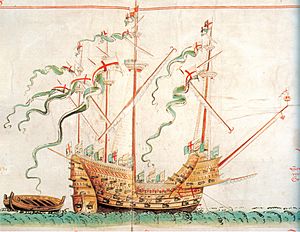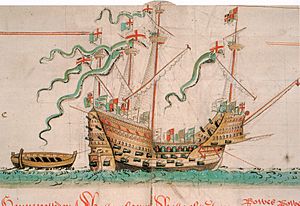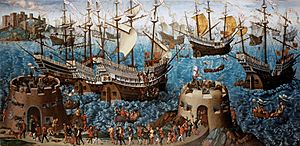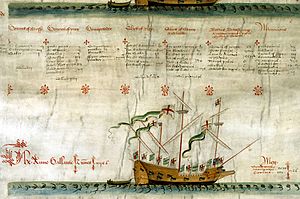Anthony Roll facts for kids

The Anthony Roll is a special old book that lists the ships of the English navy in the 1540s. It's named after the person who created it, Anthony Anthony.
This record was originally three long rolls made of vellum (a type of treated animal skin). It showed 58 navy ships with details about their size, crew, weapons, and basic gear. The rolls were given to King Henry VIII in 1546. They were kept in the royal library.
Later, in 1680, King Charles II gave two of the rolls to Samuel Pepys. Pepys had them cut up and put together into one book. This book is now at the Pepys Library in Magdalene College, Cambridge. The third roll stayed with the royal family. It was later sold to the British Museum in 1858 and is now at the British Library.
The Anthony Roll is the only known fully illustrated list of English navy ships from the Tudor period. Even though the pictures are simple, they show important details. The lists of items on the ships are very accurate. The pictures also show how ships were decorated with heraldry, flags, and other ornaments.
The Anthony Roll has the only known pictures of famous Tudor ships like the Henry Grace à Dieu and the Mary Rose. The Mary Rose sank in 1545 and was brought up from the sea in 1982. Comparing the Roll's information with the actual ship has taught us a lot about naval history from that time.
Contents
Who Created the Anthony Roll?
Anthony Anthony (who lived from before 1530 to around 1564) is known as the person who put together the information and drew the pictures. We know this from his signature.
Anthony's father came from Flanders and moved to England. Anthony followed his father's path, supplying beer to the navy. In 1533, Anthony became a gunner at the Tower of London. He later became an overseer in the Ordnance Office. This office was in charge of giving weapons to the army. It was in this job that he created the Roll. He continued to supply weapons to English forces until he died.
The Roll's Journey Through Time
Pictures of ships have been around for a long time. The Anthony Roll is part of a tradition of artworks that served two purposes. First, they were useful guides that listed details about ships. Second, they were impressive pictures that showed off the Tudor military's strength. These pictures helped to please the king and impress visitors from other countries.
The navy grew a lot during Henry VIII's rule. The king was very interested in warships. A famous painting called Embarkation of Henry VIII at Dover shows the ships that took the king to a meeting in France in 1520. This painting might have inspired Anthony's illustrations.
It's not known exactly when Anthony started or finished the rolls. We only know he gave them to the king in 1546. The Mary Rose, which sank in 1545, is included in the Roll. This doesn't mean it was started before the sinking. People still hoped to raise the Mary Rose even a few years later. Some ships listed in the Roll were still being built in 1546.

After the rolls were given to the king, they were kept in the royal collections. In 1680, King Charles II gave two of the rolls to Samuel Pepys. Pepys was a navy official and loved collecting books. Pepys was planning to write a history of the navy and was collecting materials for it. It's thought that King Charles gave him the rolls as a gift.
The second roll was thought to be lost for a while. But it actually stayed with the royal family. King William IV gave it to his daughter, Lady Mary Fox, in the early 1800s. In 1857, the second roll was shown to Frederic Madden of the British Museum. Mary Fox wanted to sell it. It was sold to the British Museum for £15 and is now at the British Library.
The Anthony Roll has been used a lot by historians studying the English navy. But the full text and all the pictures were not put into one book until the year 2000.
What the Anthony Roll Looks Like
The Anthony Roll was originally three separate rolls made of vellum. Today, the first and third rolls are bound together as a book called Pepys 2991. The second roll, called British Library Add MS 22047, is still in its original roll form.
The three original rolls were made from 17 pieces of vellum glued together. Each piece was about 27.5 inches (70 cm) wide and 31 to 37.75 inches (79 to 96 cm) tall. When Pepys got the first and third rolls, he had them cut up and bound into a book. This changed the layout, and some parts of the pictures were cut.
The first three pictures, of the Henry Grace à Dieu, Mary Rose, and Peter Pomegranate, were too big for one page. They were spread across two pages. This caused some details to be lost where the pages bent.
The three rolls list 58 ships. They are grouped by their size and how they were built. Each ship's entry includes its name, its carrying capacity (called tonnage), its crew size, and its "ordnance, artillery, munitions and habiliments for war" (weapons and military supplies).
- The first roll lists the largest ships, called carracks, starting with the Henry Grace à Dieu.
- The second roll lists galleasses, which were ships that used both oars and sails, and one galley.
- The third roll lists smaller ships called pinnaces and "rowbarges." These were like smaller versions of galleasses.
Why the Anthony Roll is Important for History
The Anthony Roll is very special as a historical record. It's the only known fully illustrated list of a Tudor royal navy. However, the pictures are not exact photos of real life. For example, the lists of guns for each ship are thought to be accurate. But the pictures don't always match these lists perfectly. The rigging (ropes and sails) in the pictures is only roughly correct.

Comparing with the Mary Rose

Comparing the Anthony Roll with the actual Mary Rose ship (which was salvaged) has helped us check how accurate the Roll's information is. The picture of the ship gives clues about its basic structure, like how many masts and sails it had. When compared to a list of the ship's items from 1514, the picture is mostly accurate.
However, when looking closely at the details, Anthony did take some artistic freedom. The weapons in the painting seem to be exaggerated. For example, the large cannons at the back of the ship, aimed backward, would not have fit where they are shown. The number of gunports (holes for cannons) on the side of the ship is also not quite right.
The list of ammunition, small guns, longbows, arrows, and other weapons in the Roll matches what archaeologists found on the Mary Rose. Because the Anthony Roll is the closest record in time to when the Mary Rose sank, it has been very important for the archaeological project. It especially helped in guessing the size of the ship's crew.
Flags and Ship Decorations
The Anthony Roll gives detailed information about the flags used on the ships. According to flag expert Timothy Wilson, the flags shown in the Roll are "the most elaborate source we have for the flags flown on the ships of King Henry VIII."
One striking feature is the long, ceremonial streamers flying from all the ships. These have a red Saint George's Cross on a white background near the flagpole. The very long tail is striped in green and white. They often have gold paint on the red and green parts, and silver paint (which now looks black) on the white. This artistic style might show how the flags fluttered or how they were decorated with metallic threads and paint.
Along the railings of all the ships, especially the large ones, there are rows of banners. These banners show different heraldic designs. These include the English royal arms, the French arms (with fleur-de-lis), Saint George's crosses, and Henry VIII's initials ("HR") in gold on blue. You can also see the Tudor rose and the green and white colors of the House of Tudor. The pictures of the flags and banners are generally accurate in a military sense, but not always perfectly consistent.
See Also
Images for kids
-
The illustration of the Mary Rose, which has been compared to the salvaged wreck of the actual ship to determine the historical accuracy of Anthony Anthony's ship portrayals





